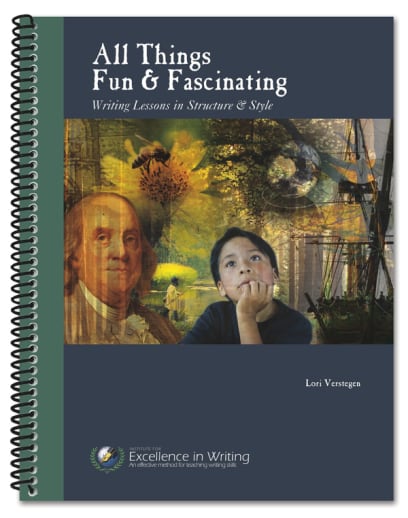What do crows, peacocks, and bird nest soup have in common? They're just a few of the fun and fascinating things that your student will WANT to write about. Within its 24 lessons (a year's worth) it covers TWSS Units 1-7 (taking notes, summarizing narrative stories, writing from pictures, mini-research report, and creative writing) and several stylistic elements. Teacher prep is non-existent; you only need to read through the lessons with your student and be prepared to be "wowed" by their writing (and, of course, do a little evaluating). Although your student will want to make a final portfolio copy of their writing assignments, all the preliminary work outlines, brainstorming charts, along with checklists are provided in the consumable, 159-page spiral-bound text. Appendices include: banned words & prepositions, substitutes for banned adjectives/verbs, and -ly words. The purchaser may download an optional accompanying teacher e-book from the publisher's website. ~ Janice
All Things Fun & Fascinating
Description
Humorous characters, cunning creatures, and meritorious men of history will captivate 3rd5th graders as they learn to write with structure and style. Moving through Units 17, students will take notes, summarize narrative stories, write from pictures, put together a mini research report, and compose creative essays.
Based on specific topics or on events in history, these sets of theme-based writing lessons from IEW (same grade-range levels as the SSS) offer comprehensive, almost scripted instruction. All necessary source texts have been developed for busy parents and teachers like you. An IEW veteran and aficionado myself, I couldn't conceive of anything more complete than what is provided here. Each lesson offers comprehensive (just short of totally scripted) instruction. All necessary source texts are provided and are reproducible for one parent/one homeschool. Clear assignments (sometimes differentiated between levels) along with a checklist to aid both the student in preparation and the parent in grading. These are also designed to be used by the student to work on throughout the week. Based on specific topics or events in various segments of history, the lessons include grammar exercises, vocabulary development, quizzes, and games for review and reinforcement - along with the writing instruction, of course.
In all lessons students are encouraged to polish their final draft perhaps even adding illustrations. At the end of each course the student will have a personal portfolio collection of poems, stories, reports, essays and research papers. Lessons are taught at the beginning of each week allowing the rest of the week for students to complete the assignment which they should be able to do on their own. Teacher preparation is minimal. (Do I hear an emphatic "Yes!"?)
The courses are targeting a progressively more competent student with the assumption that students are working through the courses according to suggested grade levels. Therefore, there is an increasing complexity to the instructions, expectations, and assignments. Accordingly, teachers are encouraged to be flexible with plans. The beginning writer may need to spend more than the suggested week on difficult lessons or omit some of the grammar. Mature students may move more quickly to allow time for additional research writing and/or more creative essay writing.
Many of these courses can be used equally well within a homeschool with several different aged students and all can be used in a co-op/support school setting with more grade-specific groupings of students. It's assumed that parents/teachers have completed Teaching Writing Structure & Style (TWSS), IEW's DVD seminar for parents and teachers.
Some courses have both a Teacher and a Student Book. In these courses, instruction for the teacher is more extensive and both books are necessary as the course is designed to be interactive between the teacher and student. Teachers should plan to read over the lessons with the students and help as necessary, especially with outlining and brainstorming. A roll of tickets (available at office supply stores) is optional but very useful for encouragement and motivation. ~ Janice
| Product Format: | Softcover Book |
|---|---|
| Grades: | 3-5 |
| Brand: | Institute for Excellence in Writing |
| ISBN: | 9780980100525 |
| Length in Inches: | 11 |
| Width in Inches: | 9 |
| Height in Inches: | 0.5 |
| Weight in Pounds: | 0.925 |

